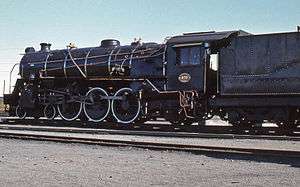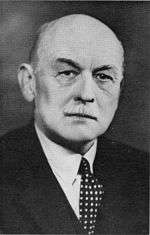South African Class 16DA 4-6-2 1928
The South African Railways Class 16DA 4-6-2 of 1928 was a steam locomotive.
| South African Class 16DA 4-6-2 1928 | |||||||||||||||||||||||||||||||||||||||||||||||||||||||||||||||||||||||||||||||||||||||||||||||||||||||||||||||||||||
|---|---|---|---|---|---|---|---|---|---|---|---|---|---|---|---|---|---|---|---|---|---|---|---|---|---|---|---|---|---|---|---|---|---|---|---|---|---|---|---|---|---|---|---|---|---|---|---|---|---|---|---|---|---|---|---|---|---|---|---|---|---|---|---|---|---|---|---|---|---|---|---|---|---|---|---|---|---|---|---|---|---|---|---|---|---|---|---|---|---|---|---|---|---|---|---|---|---|---|---|---|---|---|---|---|---|---|---|---|---|---|---|---|---|---|---|---|---|
 Hohenzollern-built no. 870, 4 April 1979 | |||||||||||||||||||||||||||||||||||||||||||||||||||||||||||||||||||||||||||||||||||||||||||||||||||||||||||||||||||||
| |||||||||||||||||||||||||||||||||||||||||||||||||||||||||||||||||||||||||||||||||||||||||||||||||||||||||||||||||||||
| |||||||||||||||||||||||||||||||||||||||||||||||||||||||||||||||||||||||||||||||||||||||||||||||||||||||||||||||||||||
| |||||||||||||||||||||||||||||||||||||||||||||||||||||||||||||||||||||||||||||||||||||||||||||||||||||||||||||||||||||
| |||||||||||||||||||||||||||||||||||||||||||||||||||||||||||||||||||||||||||||||||||||||||||||||||||||||||||||||||||||
In 1928, the South African Railways placed six Class 16DA steam locomotives with a 4-6-2 Pacific type wheel arrangement in passenger train service. Eight more entered service in 1929.[1][2]
Manufacturers
Further orders for locomotives similar to the Class 16D Pacific type locomotive were placed for the South African Railways (SAR) in 1928. The design of the earlier engines was modified by the Chief Mechanical Engineer (CME), Colonel F.R. Collins DSO, along the same lines as his design of the Class 15CA Mountain type.[1][2][3]

This consisted of a locomotive bar frame which was shorter to end at the front of the firebox, with a bridle casting to create a widened frame extension below the firebox and the cab to the rear dragbox to gain more ashpan room under the firebox.[1][2]
These redesigned locomotives were designated Class 16DA and were built by two manufacturers in 1928 and 1929. The first six, numbered in the range from 868 to 873, were built in Germany by Hohenzollern Locomotive Works and entered service in 1928. Another eight locomotives, numbered in the range from 843 to 850, were built in the United States of America by Baldwin Locomotive Works and entered service in 1929.[1][2]
Characteristics
The Hohenzollern and Baldwin-built Class 16DA locomotives basically differed from the predecessor Class 16D only by virtue of its shortened frame and bridle casting, the Class 16D having had a frame extending all the way from the front buffer beam to the rear dragbox. They used the same Type KT tenders with a coal capacity of 14 long tons (14.2 tonnes) and a water capacity of 6,000 imperial gallons (27,300 litres). As delivered, they had 60 inches (1,524 millimetres) diameter coupled wheels and their cylinders were of 22 inches (559 millimetres) bore and 26 inches (660 millimetres) stroke. Their boiler operating pressure was set at 195 pounds per square inch (1,344 kilopascals).[2][3]
Modification
During the 1940s six of these locomotives, three from each manufacturer group, were retyred with 63 inches (1,600 millimetres) diameter tyres on their coupled wheels. To not have their tractive effort reduced by the larger coupled wheels, their cylinders were reamed from a bore of 22 to 23 inches (559 to 584 millimetres) and their operating boiler pressure was raised to 205 pounds per square inch (1,410 kilopascals). All the modified locomotives remained classified as Class 16DA.[4][5]
When the larger tyres were fitted, the old tyres were left in position and turned down on the wheel centres to serve as liners and the new tyres were then shrunk on over the liners. The practice of increasing the diameter of coupled wheels, wheel spacing and other considerations permitting, was begun by A.G. Watson during his term in office as CME and was continued by his successors. The reduction of tractive effort caused by the larger wheels was made up by increasing boiler pressures or by fitting larger cylinders or both, as required. This policy resulted in more mileage between heavy repairs, less cost-per-mile on repairs and locomotives capable of higher speeds.[2]
Service
The Class 16DA Pacifics were initially placed in passenger service between Johannesburg and Kimberley where they regularly worked trains like the Union Express and Union Limited, which became the Blue Train after the Second World War. From 1930 the new Henschel-built wide-firebox Class 16DA took over this duty.[6][7]
In 1939-1940, when new air-conditioned rolling stock was placed in service on the Union Limited and Union Express services between Cape Town and Johannesburg, all the Class 16DA and Class 16E locomotives were transferred to Bloemfontein in the Orange Free State. From here, they continued to work passenger trains north and south, including the Orange Express, until the Class 15F replaced them and they were relegated to suburban and local passenger train work. By the early 1950s, the suburban trains to Lynchfield and Melorane were handled by narrow-firebox Class 16DA locomotives which only occasionally worked mainline passenger trains by then. They were withdrawn from service in 1973.[6][8]
Four of the Baldwin-built locomotives were sold into industrial service. No. 844 went to Hlobane Colliery in Natal and later to Umgala Colliery. Numbers 845, 847 and 848 went to Wankie Colliery in Rhodesia, where they became numbers 5 to 7 in reverse order. After they were finally withdrawn in 1982, one of these three was plinthed alongside the main North road at Hwange. Another of the Baldwin-built locomotives, no. 850, is plinthed at Theunissen in the Free State.[3]
Works numbers
The table lists the Hohenzollern and Baldwin Class 16DA engine numbers, builders, years built, works numbers and variations in coupled wheel sizes.[4][5]
SAR No. |
Builder |
Year |
Works No. |
Coupled wheel dia. |
|---|---|---|---|---|
| 843 | Baldwin | 1929 | 60820 | 63"/1600mm |
| 844 | Baldwin | 1929 | 60821 | 60"/1524mm |
| 845 | Baldwin | 1929 | 60822 | 60"/1524mm |
| 846 | Baldwin | 1929 | 60823 | 63"/1600mm |
| 847 | Baldwin | 1929 | 60824 | 60"/1524mm |
| 848 | Baldwin | 1929 | 60825 | 63"/1600mm |
| 849 | Baldwin | 1929 | 60826 | 60"/1524mm |
| 850 | Baldwin | 1929 | 60827 | 60"/1524mm |
| 868 | Hohenzollern | 1928 | 4653 | 63"/1600mm |
| 869 | Hohenzollern | 1928 | 4654 | 63"/1600mm |
| 870 | Hohenzollern | 1928 | 4655 | 60"/1524mm |
| 871 | Hohenzollern | 1928 | 4656 | 60"/1524mm |
| 872 | Hohenzollern | 1928 | 4657 | 60"/1524mm |
| 873 | Hohenzollern | 1928 | 4658 | 63"/1600mm |
Preservation
| Number | Works nmr | THF / Private | Leaselend / Owner | Current Location | Outside SOUTH AFRICA | ? |
|---|---|---|---|---|---|---|
| 848 | Private | Wanki Collery | Main Street | Zimbabwe | next to Wanki Highway | |
| 850 | Private | Theunissen Municipality | Main Street | |||
| 870 | THF | Krugersdorp Locomotive Depot | ||||
| 876 | THF | Transnet Heritage Foundation (Museum) | Bloemfontein Locomotive Depot | |||
| 878 | THF | Transnet Engineering | Bloemfontein Locomotive Depot | |||
| 879 | THF | Ceres Railway Company | Cape Town Station |
Illustration
.jpg) Baldwin-built no. 850 at Theunissen, 29 May 2005
Baldwin-built no. 850 at Theunissen, 29 May 2005- Baldwin-built no. 844 at the SANRASM South Site, June 2011
References
| Wikimedia Commons has media related to South African Class 16DA 4-6-2 1928 Hohenzollern. |
| Wikimedia Commons has media related to South African Class 16DA 4-6-2 1929 Baldwin. |
- Holland, D. F. (1972). Steam Locomotives of the South African Railways. 2: 1910-1955 (1st ed.). Newton Abbott, Devon: David & Charles. pp. 57–58. ISBN 978-0-7153-5427-8.
- Espitalier, T.J.; Day, W.A.J. (1946). The Locomotive in South Africa - A Brief History of Railway Development. Chapter VII - South African Railways (Continued). South African Railways and Harbours Magazine, May 1946. pp. 375-376.
- Durrant, A. E. (1989). Twilight of South African Steam (1st ed.). Newton Abbott, London: David & Charles. p. 94. ISBN 0715386387.
- South African Railways & Harbours/Suid Afrikaanse Spoorweë en Hawens (15 Aug 1941). Locomotive Diagram Book/Lokomotiefdiagramboek, 3'6" Gauge/Spoorwydte. SAR/SAS Mechanical Department/Werktuigkundige Dept. Drawing Office/Tekenkantoor, Pretoria. pp. 23-24.
- South African Railways & Harbours/Suid Afrikaanse Spoorweë en Hawens (15 Aug 1941). Locomotive Diagram Book/Lokomotiefdiagramboek, 2'0" & 3'6" Gauge/Spoorwydte, Steam Locomotives/Stoomlokomotiewe. SAR/SAS Mechanical Department/Werktuigkundige Dept. Drawing Office/Tekenkantoor, Pretoria. pp. 6a-7a, 23-24.
- Paxton, Leith; Bourne, David (1985). Locomotives of the South African Railways (1st ed.). Cape Town: Struik. pp. 10–11, 67. ISBN 0869772112.
- Soul of A Railway, System 7, Western Transvaal, based in Johannesburg, Part 26: Braamfontein West to Klerksdorp (home signal) by Les Pivnic, Part 1. Caption 18. (Accessed on 6 May 2017)
- Soul of A Railway, System 5, Part 1: Bloemfontein. Caption 1. (Accessed on 1 March 2017)